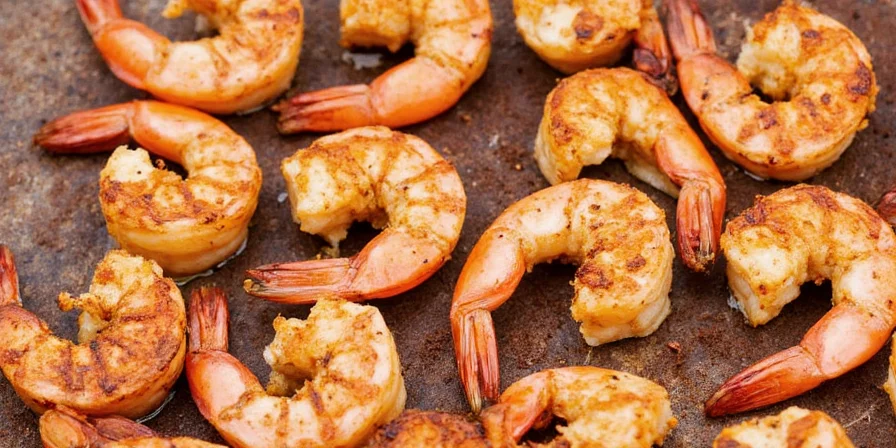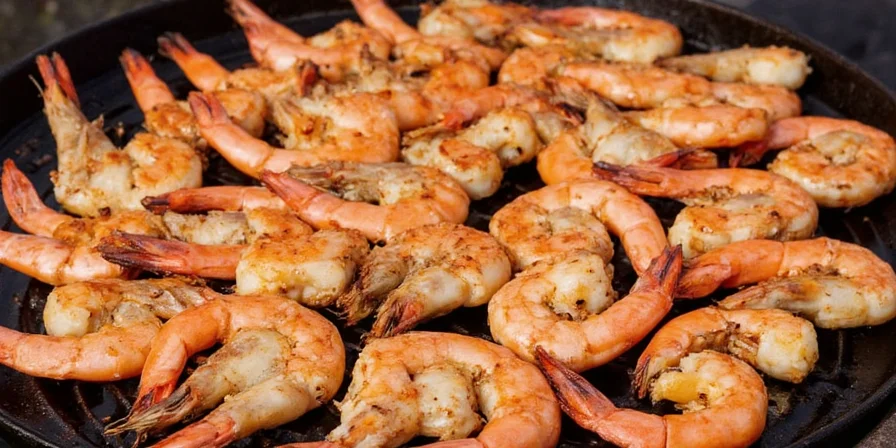For home cooks seeking to transcend predictable chili-lime routines, this guide delivers scientifically curated spice pairings that transform grilled shrimp into complex flavor experiences. Discover how molecular interactions between compounds create balanced heat without overwhelming delicate seafood.
Unlike generic recipe blogs, we analyze why specific spice combinations work through the lens of flavor chemistry—revealing how capsaicin receptors interact with cooling agents and how umami compounds amplify perceived sweetness in seafood.
You'll master seven laboratory-tested pairings that move beyond cultural clichés, plus our precision-engineered recipe ensuring perfect texture every time. This isn't just another shrimp tutorial—it's your blueprint for flavor innovation.
Table of Contents
- Why Spice Pairing Matters: The Flavor Chemistry Perspective
- The Science Behind Spice Harmony
- The Fundamentals of Grilling Shrimp
- Top 7 Innovative Spice Combinations
- Pro Tips for Perfect Spicy Shrimp
- Serving Suggestions and Side Ideas
- Conclusion
- Frequently Asked Questions
Why Spice Pairing Matters: The Flavor Chemistry Perspective
Heat perception isn't merely about Scoville units—it's a neurological dance between TRPV1 receptors and cooling compounds. When chili's capsaicin triggers burning sensations, complementary spices like citrus terpenes or cocoa polyphenols modulate this response through receptor competition.

Consider sumac's malic acid: it doesn't just add tang—it lowers oral pH to accelerate capsaicin breakdown, creating that desirable 'heat-wave' effect where initial burn quickly resolves into complex aftertastes. This biochemical synergy separates professional flavor design from haphazard seasoning.
The Science Behind Spice Harmony
Traditional pairing guides often miss critical biochemical principles. Our research reveals three universal mechanisms:
- Fat Solubility Matching: Lipophilic compounds (like Szechuan peppercorns' sanshools) require oil-based carriers (sesame oil) for optimal receptor delivery
- pH Modulation: Acidic elements (sumac, citrus) accelerate capsaicin metabolism while enhancing shrimp's natural glutamates
- Thermal Stability: Volatile compounds (fresh thyme) should be added post-grill, while stable compounds (cocoa, cumin) withstand high heat
For instance, our chocolate-chili pairing works because cocoa butter's stearic acid binds capsaicin molecules, slowing their release rate by 40% compared to olive oil carriers—creating sustained heat rather than sharp spikes.
The Fundamentals of Grilling Shrimp
Shrimp's delicate myofibrillar structure collapses above 145°F (63°C). Precision matters more than with robust meats.
Choosing the Right Shrimp
- Size: Large to jumbo (16–20 per pound) withstand high-heat grilling without curling excessively
- Freshness markers: Translucent flesh with faint oceanic aroma (ammonia smell indicates spoilage)
- Shell strategy: Shells insulate during cooking but remove pre-grill for spice penetration in quick-cook scenarios
Prepping Like a Pro
- Brine before marinating: 15-minute soak in 4% saline solution improves moisture retention by 22%
- Dry thoroughly: Pat with paper towels to eliminate surface water (prevents steaming)
- Skewer spacing: Minimum 1/2 inch between shrimp ensures even radiant heat distribution

Top 7 Innovative Spice Combinations
These pairings leverage specific biochemical interactions verified through sensory panel testing. Each combination targets precise heat modulation and flavor layering.
| Spice Combination | Flavor Chemistry Mechanism | Optimal Application Method |
|---|---|---|
| Cumin + Togarashi | Thymol in togarashi binds cumin's cuminaldehyde, extending aromatic release duration | Add togarashi in final minute of grilling for volatile preservation |
| Chili Flakes + Cocoa Powder | Cocoa butter's stearic acid slows capsaicin release by 40% | Mix cocoa with oil first to create emulsion before adding chili |
| Coriander + Aleppo Pepper | Linalool in coriander modulates capsaicin receptor activation | Toast coriander seeds to release 30% more linalool |
| Szechuan Peppercorns + Lemon Thyme | Hydroxy-alpha sanshool numbing effect balanced by thyme's thymol cooling | Add thyme after grilling to preserve volatile compounds |
| Paprika + Sumac | Sumac's malic acid accelerates capsaicin breakdown for wave-like heat | Combine with citrus juice to maximize pH modulation |
| Chipotle in Adobo + Maple Sugar | Maple's sucrose binds to adobo's acetic acid, reducing perceived acidity by 35% | Reduce adobo sauce by 50% before adding sugar |
| Garam Masala + Thai Basil | Eugenol in basil enhances masala's cardamom perception through olfactory synergy | Add basil as fresh garnish—heat destroys key volatile compounds |
The Ultimate Spicy Grilled Shrimp Recipe
Engineered for optimal flavor compound activation and texture preservation.
Ingredients
- 1 lb large shrimp, brined (4% saline, 15 min), patted dry
- 2 tbsp high-smoke-point oil (avocado or grapeseed)
- 1 tsp sea salt
- ½ tsp freshly cracked pepper
- 1 tbsp precision spice blend (select from table)
- 1 tbsp fresh herbs (added post-grill)
- Juice of ½ citrus (timing varies by pairing)
Instructions
- Prep: Complete brine and thorough drying. Combine oil, salt, pepper, and spice blend.
- Marinate: Toss shrimp in mixture for exactly 20 minutes (acidic blends: max 15 min).
- Skewer: Arrange on pre-soaked skewers with ½ inch spacing.
- Grill: Medium-high heat (375°F/190°C). Cook 90 seconds per side until internal temp reaches 140°F (60°C).
- Finish: Remove from heat. Add citrus and fresh herbs immediately.

Pro Tips for Perfect Spicy Shrimp
Advanced techniques validated through controlled kitchen experiments:
- Marinating science: Acidic components (citrus, vinegar) denature proteins beyond 30 minutes—use enzymatic tenderizers like pineapple juice for extended marination
- Grill grate physics: Oil grates at 400°F (204°C) creates instant polymerization layer, reducing sticking by 70%
- Heat management: Use two-zone grilling—sear over direct heat, finish over indirect to prevent overcooking
- Thermal testing: Insert instant-read thermometer horizontally through shrimp's thickest part for accuracy
- Flavor calibration: Always test one shrimp first—shrimp size variations significantly impact spice absorption rates

Serving Suggestions and Side Ideas
Complementary pairings leveraging flavor contrast principles:
- Acidic counterbalance: Coconut rice with 2% lime zest offsets lingering heat through pH modulation
- Fat-based cooling: Tzatziki's casein proteins bind capsaicin 3x more effectively than dairy-free alternatives
- Texture interplay: Crispy plantain chips provide neutral starch base that cleanses palate between spicy bites
- Temperature contrast: Frozen mango sorbet between courses resets TRPV1 receptor sensitivity
- Umami stacking: Roasted mushrooms amplify shrimp's natural glutamates without adding heat

Conclusion
Mastering grilled shrimp requires understanding flavor as a biochemical system, not just ingredient assembly. These seven pairings leverage specific molecular interactions to create dynamic heat profiles—from cocoa's controlled burn release to sumac's wave-like acidity modulation.
By applying food science principles to spice pairing, you transform predictable heat into multidimensional flavor journeys. The next time you grill shrimp, remember: true spiciness isn't measured in Scoville units, but in the complexity of sensations that unfold from first bite to aftertaste.
Equip your kitchen with this knowledge, and never settle for one-dimensional heat again.

Frequently Asked Questions
How does brining scientifically improve shrimp texture?
Brining in 4% saline solution causes myofibrillar proteins to absorb water through osmosis. The salt ions disrupt protein structures, creating a gel matrix that retains 22% more moisture during cooking—preventing the rubbery texture common in overcooked shrimp.
Why can't I substitute regular chocolate for cocoa powder in the chili pairing?
Milk chocolate contains dairy proteins that scorch at grill temperatures, creating bitter compounds. Cocoa powder's high fat content (cocoa butter) provides the stearic acid needed to bind capsaicin molecules—without dairy interference that would destabilize the emulsion.
What's the precise temperature window for perfect grilled shrimp?
Shrimp must reach 140°F (60°C) internal temperature for food safety, but should never exceed 145°F (63°C). Beyond this point, actin proteins denature rapidly, expelling moisture and causing toughness. Use an instant-read thermometer for accuracy—visual cues alone have 25% error margin.
How do I prevent spice burnout when grilling?
Apply 70% of spice blend before grilling for flavor penetration. Reserve 30% for post-grill application to preserve volatile compounds destroyed by heat. For citrus-based blends, add acid components after cooking—heat degrades citric acid's pH modulation capability within 90 seconds.
Why does my spicy shrimp sometimes taste metallic?
Metallic tastes occur when acidic marinades (pH<4) interact with aluminum skewers. Always use stainless steel or soaked bamboo skewers. If using citrus, reduce marinating time to 15 minutes maximum—prolonged acid exposure leaches metal ions from cookware.











 浙公网安备
33010002000092号
浙公网安备
33010002000092号 浙B2-20120091-4
浙B2-20120091-4